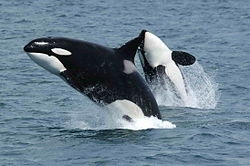| Orcininae | |
|---|---|
 | |
| Scientific classification | |
| Kingdom: | Animalia |
| Phylum: | Chordata |
| Class: | Mammalia |
| Order: | Artiodactyla |
| Infraorder: | Cetacea |
| Family: | Delphinidae |
| Subfamily: | Orcininae |
Orcininae is a contested subfamily of oceanic dolphins composed of 1 living and 3 extinct genera. [1] [2] It may be superseded by Delphinidae. [3] Its only extant member is the orca (Orcinus orca); all other extant genera formerly classified in it have been moved out. [4]
The Atlantic white-sided dolphin (Leucopleurus acutus) is sister to all other members of the Delphinidae; within that clade, the Orcininae are sister to all remaining lineages. [5]
